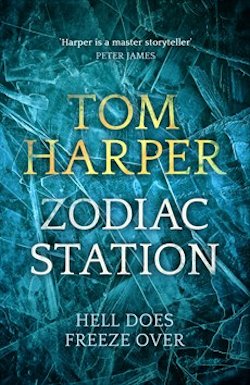An uncanny account of the circumstances surrounding the murder of the members of a remote outpost near the North Pole, Tom Harper’s taut new novel—a conspiracy-ridden riff on The Thing—is thrilling and quite literally chilling.
I suppose you know about Utgard. It’s the last place in the world, the most northerly scrap of land on the planet. Easy to miss—so easy, in fact, that no one realised it was there until the twentieth century. Most of it’s covered in ice, so much that the weight has actually pushed the land below sea level. Not that there’s much sea, either: for ten months of the year it’s frozen solid. The only notable population is polar bears, and a couple of dozen scientists at Zodiac Station. I wouldn’t like to say who’s hairier.
Zodiac Station’s story unfolds in several stages. In the framing tale we have Carl Franklin, Captain of the US Coast Guard cutter Terra Nova: “an ice-reinforced vessel capable of making a steady three knots through four-foot ice, of smashing her way to the North Pole if need be. She’d already been there twice in her short working life.” For now, the ship simply sits, as the cutter’s complement of clever-clogs set about sciencing the pristine scenery.
Lucky for the geeks that they’re guarded by men with weapons, as they aren’t as alone as they think.
Out of the fog falls a fearsome figure: a fellow dressed in red and bleeding from the belly—name of Anderson, apparently. In short order he’s shepherded to the sickbay aboard the Terra Nova, where, a little later, he explains who he is—a research assistant whose help was requested by Dr Hagger, a big-shot biochemist whose controversial conclusions have been called into question—and exactly what happened at Zodiac… or else what he thinks did:
I know it sounds ridiculous, that someone would be killed for a few numbers on a graph. But there’s a lot of money chasing round the Arctic. Ice caps are melting; places that have been out of bounds for fifty thousand years are suddenly opening up. Just when we thought we had the planet all parcelled out, it turns out there’s a bit more to grab. People get foolish when they think they can have something for nothing. And if fools and money are involved, anything can happen.
Anything, up to and including mass murder, as Captain Franklin finds when the helo he sends to the site of the station returns to the Terra Nova weighed down by bodies.
This is but the first piece of the cryptic puzzle Harper has crafted. Crucially, there are several other survivors, and they have stories to tell, too… stories that differ markedly from Anderson’s. “Either he’s one unlucky son of a bitch,” the Captain concludes, “or he’s more dangerous than we can imagine.”
The unreliable narrators of Zodiac Station are a large part of its appeal. It seems a simple business to begin with—Anderson says this, another character that—but as the fiction quickens, the incidental tension in the text gives way to a sense of something substantially more sinister. This isn’t about gilding the lily any longer; suddenly we see the survivors’ little white lies as deliberate deceits. Someone is covering up their role in the devastation of Zodiac Station, and that same someone is responsible for dozens of deaths.
These deaths are practically predestined, for we know how from the get-go the unfortunate fate of most of the folks we meet. That said, the time we spend with these characters is vital. Harper uses it to humanise the major players, such that the horrible thing that happens to them—an abstract aspect of the narrative at the outset—has actual impact when we encounter it again at the end.
I’m afraid the characterisation of the isolated scientists is leaps and bound better than that of Carl Franklin and the crew of the Terra Nova. As a frame, this section fits fine, but its role in the overall story is at best superfluous. Clearly, Harper could have tried harder here. As regards the extensive research he underwent, however, it rings out throughout—particularly in terms of Zodiac Station’s authentic setting. It’s otherworldly, in a word:
It looked like a spaceship landed on an alien planet. The main building was a low, green oblong jacked up on spindly steel legs. A white geodesic dome bulged out of the roof; the rest of it was covered with a mess of masts, aerials, satellite dishes and solar panels. Subsidiary buildings clustered around it: a mix of faded wooden huts in assorted sizes, curved-roofed Nissen huts, and bulbous orange spheres with round portholes, like deep-sea submersibles left behind by a sinking ocean. Flags fluttered from a line of red poles that staked the perimeter, a shallow semicircle down to the frozen edge of the fjord.
Zodiac Station doesn’t invoke the spectre of the supernatural in the spirit of its closest contemporary, The Terror by Dan Simmons, yet there’s the suggestion, as subtle as it is inevitably unsettling, that anything could be out there, beyond the above border. Add that to the questionable perspectives presented, a confident cast of characters and a tremendous sense of setting, and what have you got? Tom Harper’s new novel: in my book his best yet.
Zodiac Station is available June 19th from Hodder & Stoughton.
Niall Alexander is an extra-curricular English teacher who reads and writes about all things weird and wonderful for The Speculative Scotsman, Strange Horizons, and Tor.com. He’s been known to tweet, twoo.










